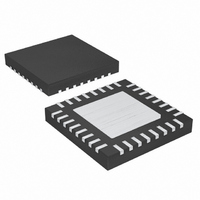MAX1518BETJ+T Maxim Integrated Products, MAX1518BETJ+T Datasheet - Page 18

MAX1518BETJ+T
Manufacturer Part Number
MAX1518BETJ+T
Description
IC DC-DC CONV TFT-LCD 32-TQFN
Manufacturer
Maxim Integrated Products
Datasheet
1.MAX1518BETJT.pdf
(25 pages)
Specifications of MAX1518BETJ+T
Applications
Converter, TFT, LCD
Voltage - Input
2.6 ~ 6.5 V
Number Of Outputs
1
Voltage - Output
2.6 ~ 13 V
Operating Temperature
-40°C ~ 100°C
Mounting Type
Surface Mount
Package / Case
32-TQFN Exposed Pad
Lead Free Status / RoHS Status
Lead free / RoHS Compliant
The minimum inductance value, peak current rating,
and series resistance are factors to consider when
selecting the inductor. These factors influence the con-
verter’s efficiency, maximum output load capability,
transient-response time, and output voltage ripple. Size
and cost are also important factors to consider.
The maximum output current, input voltage, output volt-
age, and switching frequency determine the inductor
value. Very high inductance values minimize the cur-
rent ripple and therefore reduce the peak current,
which decreases core losses in the inductor and con-
duction losses in the entire power path. However, large
inductor values also require more energy storage and
more turns of wire, which increases size and can
increase conduction losses in the inductor. Low induc-
tance values decrease the size but increase the current
ripple and peak current. Finding the best inductor
involves choosing the best compromise between circuit
efficiency, inductor size, and cost.
The equations used here include a constant LIR, which
is the ratio of the inductor peak-to-peak ripple current
to the average DC inductor current at the full load cur-
rent. The best trade-off between inductor size and cir-
cuit efficiency for step-up regulators generally has an
LIR between 0.3 and 0.5. However, depending on the
AC characteristics of the inductor core material and
ratio of inductor resistance to other power-path resis-
tances, the best LIR can shift up or down. If the induc-
tor resistance is relatively high, more ripple can be
accepted to reduce the number of turns required and
increase the wire diameter. If the inductor resistance is
relatively low, increasing inductance to lower the peak
current can decrease losses throughout the power
path. If extremely thin high-resistance inductors are
used, as is common for LCD-panel applications, the
best LIR can increase to between 0.5 and 1.0.
Once a physical inductor is chosen, higher and lower
values of the inductor should be evaluated for efficien-
cy improvements in typical operating regions.
Calculate the approximate inductor value using the typ-
ical input voltage (V
(I
an appropriate curve in the Typical Operating
Characteristics section, and an estimate of LIR based
on the above discussion:
TFT-LCD DC-DC Converter with
Operational Amplifiers
18
MAIN(MAX)
______________________________________________________________________________________
), the expected efficiency (η
IN
), the maximum output current
Main Step-Up Regulator
Design Procedure
Inductor Selection
TYP
) taken from
Choose an available inductor value from an appropriate
inductor family. Calculate the maximum DC input cur-
rent at the minimum input voltage (V
servation of energy and the expected efficiency at that
operating point (η
in the Typical Operating Characteristics:
Calculate the ripple current at that operating point and
the peak current required for the inductor:
The inductor’s saturation current rating and the
MAX1518B’s LX current limit (I
and the inductor’s DC current rating should exceed
I
less than 0.1Ω series resistance.
Considering the Typical Operating Circuit, the maximum
load current (I
a typical input voltage of 5V. Choosing an LIR of 0.5 and
estimating efficiency of 85% at this operating point:
Using the circuit’s minimum input voltage (4.5V) and
estimating efficiency of 80% at that operating point:
The ripple current and the peak current are:
IN(DC,MAX)
L
L
=
=
I
I
I
I
RIPPLE
PEAK
RIPPLE
PEAK
. For good efficiency, choose an inductor with
I
IN DCMAX
13
V
5
MAIN
(
V
MAIN(MAX)
V
I
IN DCMAX
V
IN
=
=
(
,
=
I
2
=
1 8
IN DCMAX
MIN
.
V
,
3 3
(
2
0 5
IN MIN
A
.
4 5
.
)
) taken from the appropriate curve
.
(
I
+
µ ×
=
13
MAIN MAX
,
A
) is 500mA with a 13V output and
H
)
V
0 74
I
L V
MAIN MAX
V
×
=
V
×
.
)
×
1 2
MAIN
V
2
−
13
0 5
(
)
(
×
4 5
IN MIN
.
13
.
+
5
A
.
(
MAIN
MHz
V
(
(
V
V
LIM
V
A
I
V
RIPPLE
MAIN
≈
×
−
−
)
×
×
2 2
1 2
) should exceed I
2
×
V
)
13
4 5
.
.
0 8
)
×
IN
× η
.
f
.
OSC
×
MHz
A
V
f
−
OSC
0 85
V
IN(MIN)
V
0 5
MIN
V
.
)
≈
MAIN
.
IN MIN
1 8
(
.
≈
≈
η
0 74
A
LIR
TYP
) using con-
.
3 3
)
)
.
A
µ
H
PEAK
,












